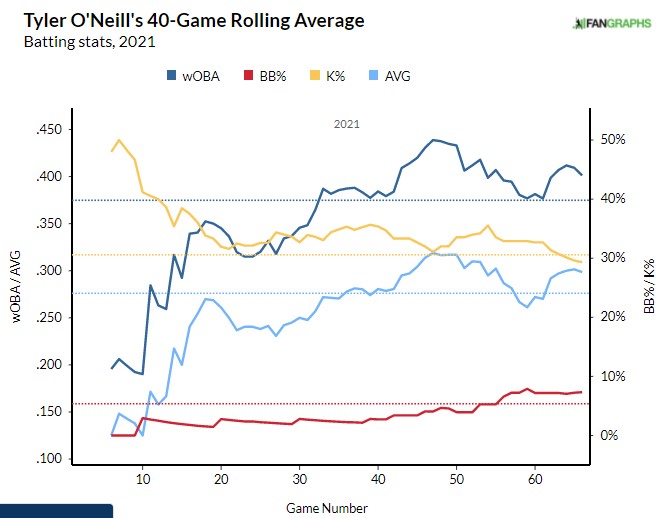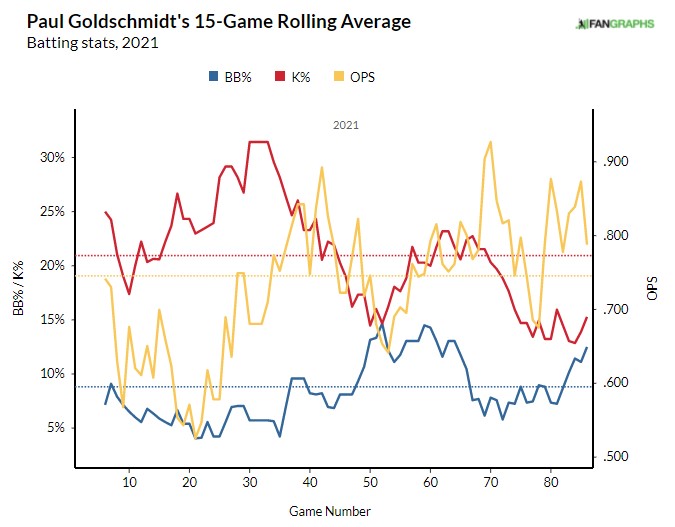My first ever article for Pitcher List was about an idea I had of combining two great hitting stats into one, for fantasy baseball analysis purposes; this led to what I called Q, a simple, yet handy, statistic for hitter-performance forecasting.
For a better grasp of what it is and how it works, I recommend reading the piece here. But here is a quick summary:
We want batters to have the highest Dynamic Hard Hit rate and the “tightest” (lowest) possible standard deviation of the Launch Angle; the former describes the batter’s capacity to hit balls hard depending on the Launch Angle at which said balls are hit, the latter tries to represent the capability that a hitter has to routinely repeat his swing as close to the same path as possible to reproduce the same Launch Angle.
Sounds complicated, but it’s all very understandable and intuitive, and you can always just check the foundational concepts linked in the mentioned article before. Basically… hit the ball hard. Repeat.
I used these relationships as an easy way to find out players with potential. This prompted me to devise and use a very simple formula called Q (for Quotient) and its expression states: Q=DHH%/Sd(LA), where DHH% is the Dynamic Hard Hit rate and Sd(LA) is the standard deviation of the Launch Angle.
That article went live in early December, last year, so, with the All-Star Game next week, it is a good time to do an audit of how things are working (or not) with it.
Matt Olson is a Legitimate MVP Candidate
I know that the AL is pretty loaded in MVP possible winners: Vladimir Guerrero Jr. has been incredibly good, triple slashing .341/.439/.679 and 28 HR, a .464 wOBA, 196 wRC+, all good for a 4.8 fWAR, ridiculously good numbers.
After seeing those numbers, it’s almost funny that there is an even better candidate, the amazingly talented Shohei Ohtani, sporting MLB-leading 32 HR, a line of .279/.364/.700, a .435 wOBA, 179 wRC+ and a 3.8 fWAR just on the offensive side of his game as while pitching he is 4-1, with a 3.49 ERA, 67 IP, 35 BB, 87 SO, a FIP of 3.58, adding a 1.5 fWAR for a marvelous 5.3 total, before the All-Star break.
So, competition is extremely tough this year, so far, but this doesn’t make Matt Olson’s numbers less good, as we can see in the following chart:
Olson, in the American League, is tied for fifth (T-5th) in homers, T-8th in RBI, T-10th in R, 12th in OBP, sixth in SLG, fifth in OPS, and eight in wOBA, among all qualified players.
In my first article, I wrote:
“However, what impressed the most was finishing with a .280/.360/.595 slash line, 47 HR, and a 175 wRC+. With those numbers, it’s expected that Matt Olson will be a finalist for–and probably win–the American League MVP Award for the 2021 season.”
Mr. Olson is really close to all those numbers, including the projection in homers and wRC+.
I know I took a big leap of faith regarding Olson, even when he was a top 10 player in Q in multiple time periods (2019, 2020, 2019-2020), entering his prime 27-years-old season and with a good track record if you took out the 2020 season.
Well, that 2020 season was abysmal as he hit for a batting average of .195 and a horrible 31.4 K%, which dragged down everything else last year.
But that’s the thing with baseball, and especially with fantasy baseball: we try to make some bold bets that can help us get an edge during the season. And, the underlying numbers and context for Olson looked good enough to gamble on, it was just a matter of him improving his contact because the great power profile, as described by Q, is there.
And what an improvement he had! He went from that hideous 31.4 K% to a current 16.1%, an incredible 50% reduction. And nowadays, you can see him defending his at-bats like this:
Although Matt Barnes had the last laugh, getting the save today against the A's, Matt Olson had a great at bat in that 9th inning, battling through 8 pitches and getting the single to get on base.
Ended the day with a hit in 3 AB, and a BB, raising his BA and OPS to .283, .923. pic.twitter.com/nRI8xqId75
— Carlos Marcano, Dick Allen Stan (@camarcano) July 5, 2021
This massive plate discipline improvement, as optimistic as I was on him, could not have been fully predicted by anyone, for sure, but I’ll take it as part of the reward on believing in him; that reward is a first/second round performance from a sixth-round pick in most 15-teams drafts, so far.
Other notable players highlighted by Q in that very early pre-season article’s leaderboards were Franmil Reyes, Teoscar Hernandez, and Rafael Devers, outside the more obvious picks like Mike Trout, Bryce Harper, Ronald Acuna Jr., Nelson Cruz, Aaron Judge, or Fernando Tatis Jr.
Using a variation of the stat, Q/QB, where QB is a term composed of Barrel% and Blast%, we found signs of potential massive power surges heading into this season from Byron Buxton, Mike Trout, and Evan White, all of them unfortunately restrained by injuries after showing initial outbursts; and also got more reasons to believe in Teoscar, plus in Adam Duvall. There had a big miss too on Matt Chapman.
You can read more on Q/QB in the corresponding article here.
Who’s Next?
I keep a three times a week updated Q and Q/B Leaderboard in this spreadsheet.
Using it during the season, one of the most interesting names that have been popping up is Tyler O’Neill, who is currently the leader for all MLB in Q with 1.358 (min. 55 BBE, through 7/7) ahead of Mike Zunino (!!!), Ronald Acuña and Shohei Ohtani, and should be considered a top reachable pick for next year’s redraft leagues, but we have to keep an eye on his health issues.
O’Neill is having a breakout season already: he is batting .276/.331/.557 with a wOBA of .375, a 140 wRC+, a 2.1 fWAR while belting 15 HR and also adding six very useful stolen bases.
He keeps improving in key metrics like K% and BB%, which reflects in his wOBA and BA:

As I said before, only health issues could get in the way of O’Neill reaching superstardom.
For dynasty leagues, Bobby Dalbec is ninth in Q with 1.019 and should be of interest for the next season if he can manage to improve his K%, which is still too high but could be a Matt Olson type of situation if he can right the ship in that regard.
Putting aside his struggles to make contact, Dalbec is seventh in Barrel% (min. 110 BBE) with 17.4%, 12th in Blast% at 10.7%, he is top 20 in Max EV at 115.6 mph, top 15 in DHH% at 25.7%, and top 25 in Sd(LA), 25.2°.
He’s got the tools, just needs to be able to hit the ball more frequently, and good things will happen.
For leagues that allow trades, I would recommend trying to get Paul Goldschmidt; his buy-low window will not be better than now as he has not had a great first half, but he still ranks in the top 25 in Q and for added context, he is consistently improving his K% and BB%, with an added effect in his OPS, as we can see in the following 40-games rolling average graph for him:

Goldschmidt has been traded in deals involving Eugenio Suárez or Tyler Naquin in Yahoo! recently, they are both trending down, so you might be able to work out a nice deal.
Something additionally important is that, for the past three seasons, Goldschmidt has had better second halves than first halves.
Finally, in case you need some cheap power, there are a couple of options in guys like Rowdy Tellez and Darin Ruf, who might be heading into getting more playing time, ranking 27th (0.877) and 29th (0.863) in Q, well above the league average of 0.407, and are available in most leagues.
Final Thoughts
Hitting is one of the most difficult athletic feats in any sport, as trying to hit a ball traveling at more than 95 mph, with a glorified stick, is an almost impossible task.
But people do it, and some of them with enough power and consistency to provide awesome stats to your team.
We can find more surprisingly good performers by keeping an eye on this type of power profile stats that combine elements of raw power like DHH%, and bat control like Sd(LA), while monitoring the rest of the peripheral stats to complete the context that will guide us to interesting picks; picks as bold as Matt Olson for MVP four months before the start of the season.
Using Q and Q/QB can point to those players that demand our attention and deeper looks into the underlying metrics that can give us a broader scenario of the players’ chances for success.
Photo by Keith Allison/Wikimedia Commons | Adapted by Jacob Roy (@jmrgraphics3 on IG)


This is fascinating, thanks so much for sharing!
I’m so glad you liked it, JH!